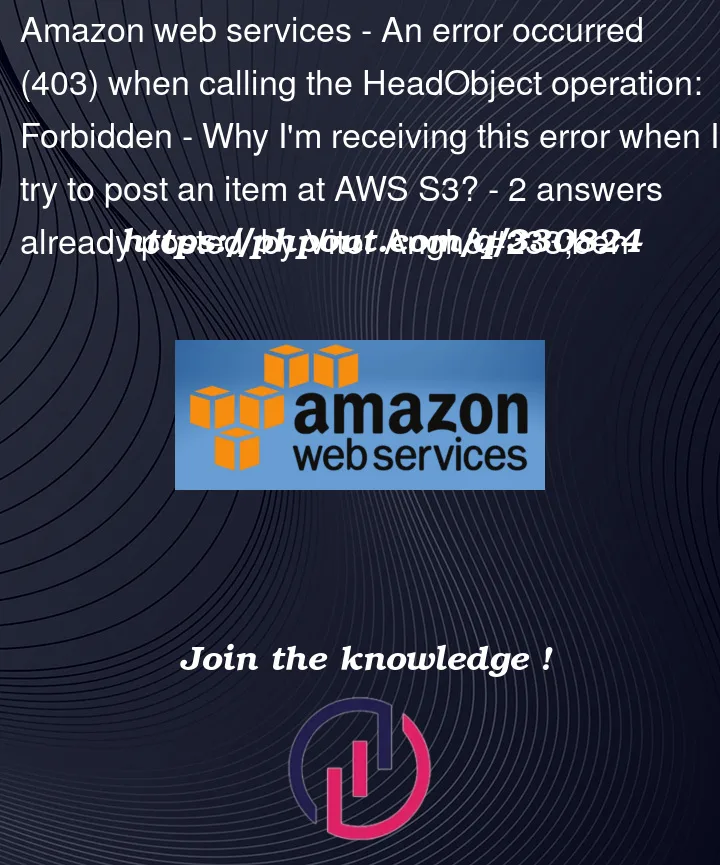I’m working in an e-commerce Django project and I’ve made the deployment of the project in an EC2 instance, but now that I’m trying to work again at my Django project I’m receiving this error when I try to create a new item
ClientError at /items/new/
An error occurred (403) when calling the HeadObject operation: Forbidden
Note that I’ve tried several different types of bucket policies and no one have work
Bucket Policy ->
{
"Version": "2008-10-17",
"Statement": [
{
"Sid": "AllowPublicRead",
"Effect": "Allow",
"Principal": "*",
"Action": "s3:*",
"Resource": [
"arn:aws:s3:::ecommercesimple",
"arn:aws:s3:::ecommercesimple/*"
]
}
]
}
settings.py ->
# Amazon S3 settings
AWS_ACCESS_KEY_ID = 'xxxxx'
AWS_SECRET_ACCESS_KEY = 'xxxx'
AWS_STORAGE_BUCKET_NAME = 'ecommercesimple'
AWS_S3_SIGNATURE_NAME = 's3v4',
AWS_S3_REGION_NAME = 'us-east-2'
AWS_S3_FILE_OVERWRITE = False
AWS_DEFAULT_ACL = None
AWS_S3_VERITY = True
DEFAULT_FILE_STORAGE = 'storages.backends.s3boto3.S3Boto3Storage'
I appreciate any help!




2
Answers
The error you are encountering (ClientError: An error occurred (403) when calling the HeadObject operation: Forbidden) typically indicates that there is an issue with the permissions of your AWS S3 bucket. Here are a few things you can check and modify:
Bucket Policy:
Ensure that your bucket policy allows the necessary actions for your AWS S3 resources. The policy you’ve shared seems to allow public read access, but you might need to adjust it to grant additional permissions depending on your use case.
IAM User Permissions:
Double-check that the AWS access key (AWS_ACCESS_KEY_ID) and secret access key (AWS_SECRET_ACCESS_KEY) you are using in your Django project have the necessary permissions to perform S3 operations. The IAM user associated with these credentials should have appropriate permissions for the actions you are trying to perform.
Bucket ACL (Access Control List):
Check the bucket’s ACL settings. You can do this through the AWS S3 console. Make sure that the ACL settings align with your intended access requirements.
AWS S3 Signature Version:
In your settings.py, you have AWS_S3_SIGNATURE_NAME = ‘s3v4’. Make sure that this is the correct signature version for your S3 bucket. In some cases, you might need to use ‘s3v4’ for AWS Signature Version 4.
Here’s a modified version of your bucket policy that grants more specific permissions. Please adjust it based on your specific requirements:
{
"Version": "2012-10-17",
"Statement": [
{
"Effect": "Allow",
"Principal": "",
"Action": [
"s3:GetObject",
"s3:PutObject",
"s3:ListBucket",
"s3:DeleteObject"
],
"Resource": [
"arn:aws:s3:::ecommercesimple",
"arn:aws:s3:::ecommercesimple/"
]
}
]
}
After making changes, make sure to restart your Django application, and try creating a new item again. If the issue persists, you might want to check the AWS CloudWatch logs for more detailed information about the error.
Policy you provided explicitly allowing all actions for all accounts! That can be dangerous so revise that.
Here is steps that will help you to troubleshoot problems with getting object headers:
curl -v -X HEAD https://ecommercesimple.s3.amazonaws.com/objKey. If that’s working rom EC2, you have problems in your AWS Credentials or setting associated with your identity.